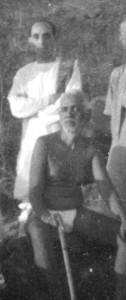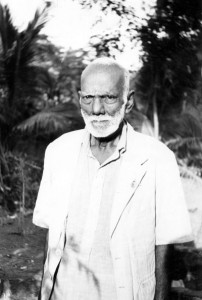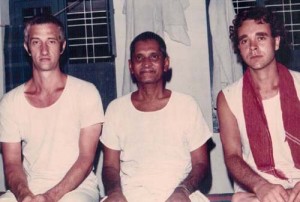Today [written on my blog in 2008] for no particular reason I feel like telling a story of some odd ‘coincidences’ that came into my life back in the 1980s.
In 1983 I was in London, staying in the house of a friend of mine, Christine Hodder. Her partner, Piers, knew a man in Hampstead who wanted someone to house sit for him while he went on holiday. Piers, who had been a devotee of Bhagavan for years, introduced me and gave me a recommendation. The man who owned the house was a retired professor of art, having taught for many years at a prestigious London art school. His main claim to fame in the academic world was discovering hidden Rosicrucian symbols in centuries-old paintings. In those days non-Christian groups had to transmit their ideas in unorthodox ways to avoid persecution by the church. I can’t remember the professor’s name, so I will continue to call him ‘the professor’. He taught perspective, possibly the most boring subject in any art curriculum, but it was one that had always fascinated him. He had looked at an old painting of a ballroom scene in which the dancers were strutting their stuff on a black-and-white chessboard-like surface, which receded off into the distance. He noted how the squares had all the right angles and foreshortening to make the perspective look realistic. As an exercise in perspective, just to amuse himself, he reconstructed the ballroom from the chandelier perspective: that is to say, he made a top view in which all the squares were squares. When he did this, he discovered that the floor was covered with secret Rosicrucian teachings, which were not visible when the ballroom was viewed from the angle that the artist had painted it. This was great fun for the art historians, who then spent the next few years checking out all the other floors in old paintings to see what might be hidden on them. Angles, optics and perspective fascinated this man, and he was rightly celebrated as a man who had opened up a whole new field in art history.
At our first meeting, which was a kind of interview for the job, we ended up talking about Plotinus, a neo-Platonist mystic. I knew about him from his writings on mysticism, and the professor knew about him because he had apparently written the world’s first treatise on optics. The professor decided that anyone who could talk intelligently about Plotinus was OK with him, so I was given the job.
He took me to the house next door to introduce me to the neighbours. He didn’t want them to call the police when they saw a strange man entering the house. I was introduced as someone who lived in an ashram in India, and who was in London on a long holiday.
‘My brother went to live in an ashram in India,’ said the neighbour. ‘A place called Tiruvannamalai. Have you heard of it?’
I laughed and told her that this was my ashram as well. Curious to hear more about her brother, I asked what his name was, and when he lived there.
I learned that her brother had been stationed in India during the Second World War and that during his visit he had been to see Bhagavan in Tiruvannamalai. The visit had made a deep impression on him. When the war was over he decided to go back to India and live permanently in Tiruvannamalai. He had stayed on after Bhagavan passed away and had apparently died there in the 1950s. His sister said that he had been buried somewhere near Ramanasramam.
She told me his name and I was a little surprised that I had never heard of it. There were not many permanent foreign residents in Tiruvannamalai in the 1940s, and I thought I knew the names of all of them. I asked the woman if she was sure that her brother was staying near Ramanasramam, and not some other ashram. She went off to another room and came back with a folder of his letters that she had kept. They were headlined ‘Ramanasramam’ with 1940s and 50s dates, and other foreigners such as Cohen and Chadwick were mentioned in them.


I can’t remember this man’s name either, but I did write it down because I wanted to check in Ramanasramam to see if anyone remembered him there. On my return I spoke to Kunju Swami, Ramaswami Pillai and a few others, but none of them could remember this mysterious British ex-soldier who had fallen in love with Bhagavan, moved to Tiruvannamalai, and died there. S. S. Cohen could probably have told me all about him, but he had passed away a couple of years before.
We went back to the professor’s house, where he gave me a quick briefing on my duties. They were not particularly onerous. He had inherited the house in the 1950s, and part of the inheritance was a large tortoise who lived in the garden. He was several decades old, impressively large, but not very intelligent. The garden was terraced and the tortoise had a life-long habit of walking off the edge of the terrace walls and falling down to the next level, where he would often end up on his back. Ramps had been specially built for him to walk between the different levels, but he often forgot to use them. Tortoises apparently cannot live for more than twenty-four hours on their backs. My only household duty, said the professor, was to go out into the garden once a day, locate the tortoise, and make sure that he was the right way up. For this, I had the run of a millionaire’s mansion in one of the most expensive and desirable corners of London. At this particular time rich Arabs were buying up the best houses in the city. Other than making sure that the tortoise was the right way up, my only other job was to say ‘no’ to the various agents who might knock on the door and offer huge amounts for the house. No one came while I was there, but the professor told me that he had been offered well over a million pounds for the place by visitors in the preceding weeks. That’s 1983 prices. I would guess that a place like that would go for over 10 million today. That’s about twenty million dollars.
It was a huge mansion, and everything in it seemed to be antique and valuable. The floors were covered in old Persian rugs; the bookshelves with leather-bound 18th and 19th century first editions; the paintings, unsurprisingly, were originals; and even the kitchen was stocked with valuable antiques. I found this out after I had had my first bowl of breakfast cereal. I washed up and left the spoon to dry on the draining board. A couple of hours later, when it had gone black, I realised that it was solid silver. I checked the hallmark and then turned over my bowl. It was Meissen china, and probably old as well. Not wanting any domestic accidents with valuable family heirlooms, I went off to Woolworth’s and bought myself some cheap plates, bowls and cutlery to eat my food off during my stay.
Down in the cellar there were thousands of bottles of what I assumed was very good wine. That assumption was based on the prices on the unopened boxes, rather than any knowledge of the subject. I found out later from my friend Piers that one reason I was given the house by the professor was that he thought it unlikely that a sadhu from India would have a riotous party and end up drinking all his wine. Even so, I found his trust quite astonishing. He had given me the house after a twenty-minute chat, having never set eyes on me before. Even though the contents of his house may well have been worth almost as much as the house itself, I had been given the run of the place after the most cursory of evaluations.
There was a living room in the centre of the house, although I suppose its various owners had probably given it a more grandiose name. It had huge bay windows that overlooked the terraced garden, which sloped down away from the house. Hampstead is on a slight hill. Beyond the garden wall the whole of London spread itself out before me, with famous landmarks such as St Paul’s cathedral clearly visible in the distance. Facing the window on the inside were an 18th century clavichord and a more modern harpsichord. Both were in tune and ready to be played. I decided to enter into the spirit of the occasion by learning a piece of old music and playing it on the antique clavichord as I faced this gorgeous panorama of London. I selected a simple section of a Bach piece from the sheet music I found inside the stool, and then, blowing the dust off the memories of piano lessons I had unwillingly endured when I was eight and nine, I spent three days mastering my little piece.
The professor, who had gone on holiday, was a creature of habit. Each year, in the same month, he headed off to the Channel Islands to spend time with an old friend. That year the strange Ramana coincidences were uppermost in his mind when he arrived. My friend Piers had revealed that he was a Ramana devotee, which was the first time the professor had ever heard the name; I was then introduced as a devotee of the same Guru; finally, on our visit to his neighbour, he discovered for the first time that his neighbour’s brother had lived at Ramanasramam and had eventually been buried nearby. He narrated this strange story to his host on their first evening together. His friend listened in silence and then left the room for a few minutes. He came back a few minutes later with a huge pile of Ramana books; the professor’s best and oldest friend had been a devotee for decades and had never bothered to tell him. It was something he liked to keep secret, but the professor’s story had persuaded him to come out of the closet.
All this was told to me on his return. He had dismissed the story of his neighbour’s brother being buried in Tiruvannamalai as an odd coincidence, but he was genuinely shocked when he discovered that his oldest friend had been a Ramana devotee for years and had never spoken to him about it.
I suppose the story should end with the professor seeing the light and turning to Ramana, but it was not to be. As I said, he was a creature of habit. He went back to his music and his art, and probably used his Ramana story as a conversation-filler on social occasions. I never saw him again.

With that story reaching a dead end, I will continue the narrative with Piers, the friend who had introduced me to the professor. I had met him in Tiruvannamalai in the 1970s, where he was a regular winter visitor. He worked as a gardener or a house painter in London, jobs that allowed him to take time off every winter and come to Tiruvannamalai. He lived, by western standards, an austere life in London. He slept on the floor in a sparsely furnished room. The few objects on view were Ramana portraits, God pictures and a few Ramana books. He liked to sit quietly in his room, absorbing himself in his inner silence. His needs were minimal since the room was in his mother’s house. He generally walked to work, ate at home, and had no interest in spending money on the usual consumer items. He lived like a sadhu whether he was in London or Tiruvannamalai. He would work as many hours as were needed to meet his meager financial obligations, and no more. Given his lifestyle, he could get by on working half a week or less, even at minimum wages. And how did he finance his trips to India? He told me that if Ramana wanted him to come to Tiruvannamalai in the winter, he would send him a big job offer around August or September. When such offers came, he took them as a sign that he should take them and save enough money for a trip to India. This happened almost every year.
There was one other aspect of his sadhana that impressed me. He would write letters to Ramana about all the things that were going on in his life. He would then ‘post’ the letters by putting them through the slit of a box that was under his Ramana photo. That way, Piers felt that Ramana would be up to speed on all the developments in his life.